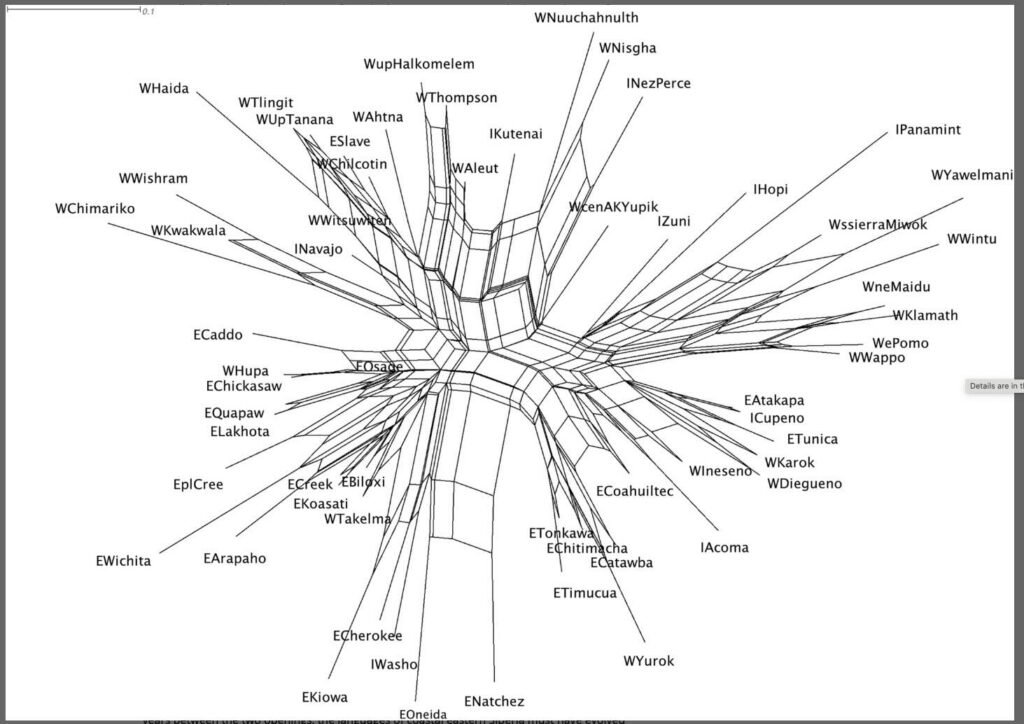A study recently published in the American Journal of Biological Anthropology proposes a new model for the initial settlement of the Americas based on an analysis of Indigenous American languages. The study integrates linguistic evidence with data from archeology and paleoclimatology to shed light on the earliest chapters in the peopling of the North America, indicating that these languages likely originated from Siberia.
Study author and linguist Johanna Nichols’ key finding is that linguistic evidence supports four main entry points into North America from Siberia: two coastal entries around 24,000 and 15,000 years ago when sea ice conditions allowed, an inland entry around 14,000 years ago via an ice-free corridor, and a final coastal entry around 12,000 years ago as coastal ice sheets retreated.
The diversity of American Indigenous languages, Nichols argues, is consistent with these multiple entries occurring over an extended period. The languages reflect two main population strata – an early coastal stratum associated with the first two entries, and a later inland/coastal stratum from the third and fourth entries.
Nichols associates specific linguistic features with particular entry points. For example, in her paper, she notes that n-m pronouns (where 1st person begins with /n/ and 2nd person with /m/) are densely clustered in Oregon and California, and may reflect a feature of the second coastal entry around 15,000 years ago.
Polysynthetic structure (where multiple ‘meanings’ can be placed into a single word via inflection, tense, mood, and grammatical structure) and noun incorporation are associated with the later inland entry and the fourth coastal entry.
In simple terms, while these languages come from some common roots in Northern Russia, their arrival in North America occurred over several millennia and, therefore, would have evolved and changed over time.


Moreover, Nichols proposes that the modern geographical distribution of language families and structural features still reflects the geography and chronology of these ancient openings and the population strata they produced. To arrive at these conclusions, Nichols surveyed 16 phonological and morphological features across 60 languages representing the diversity of North America.
Nichols’ approach was to use compiled lists of structural features that languages have, such as whether their nouns have a separate plural form or a gender system. She then scores different regional languages or language groups on each of those features. This allows for the comparison of numerous languages simultaneously, enabling researchers to spot resemblances of many kinds and even overall patterns shared by many languages. The combination of aspects covered in these analyses creates a more stable model to apply backward in time, allowing the growth and development of language to be observed via a spreadsheet.
Through these methods of charting languages, Nichols found significant evidence that the first languages of North America can be traced back to two very different language groups from Siberia. There are about 200 “independent language families of the Americas,” she wrote in her study. Something had to force this level of variation to occur, and according to her study, human migration patterns are the only real answer.
While Nichols’ study is ambitious and thought-provoking, it isn’t a slam dunk. With only 60 languages sampled, that leaves out the bulk of other languages that populated ancient North America. Moreover, it attempts to simplify linguistic evolution, and language diffusion, into something impacted almost solely by geography and topography.
The study is a good first step into the often mushy and nebulous sources of language. However, merging archaeological and paleoclimatological evidence next to language is very much a novel and unique approach. The study should be taken as putting forward hypotheses to be tested with further interdisciplinary work, rather than conclusively demonstrating the model.
“Sorting out, in this linguistically diverse population, descendants from the respective openings is a challenge for further research,” Nichols wrote in her study.
Much like those early explorers who left Siberia to populate the Americas, and left their marks here via the spoken word, this study paves an interesting path into how we research at the intersection of linguistics, archeology, and human biology.
MJ Banias covers security and technology with The Debrief. You can email him at mj@thedebrief.org or follow him on Twitter @mjbanias.

